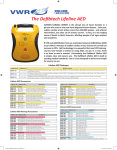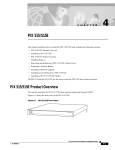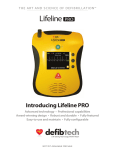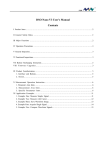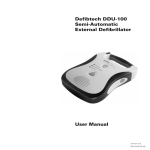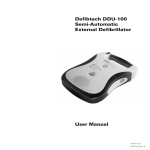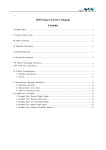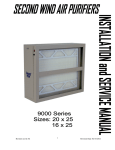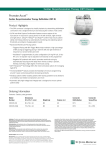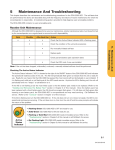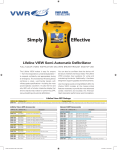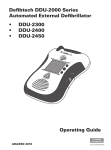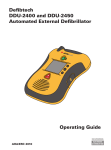Download AED Training Equipment User Manual
Transcript
AED Training Equipment - Standalone AED Trainer - Training Battery Pack System User Manual Training Software V2.2 DAC-515E Rev. B Notices Defibtech shall not be liable for errors contained herein or for incidental or consequential damages in connection with the furnishing, performance, or use of this material. Information in this document is subject to change without notice. Names and data used in the examples are fictitious unless otherwise noted. Limited Warranty The information in the Defibtech AED User Manual does not constitute any warranty as to the Defibtech AED or any related products. The “Limited Warranty” shipped with Defibtech AED products serves as the sole and exclusive warranty provided by Defibtech L.L.C. with respect to these products. Copyright Copyright 2006 Defibtech, L.L.C. All rights reserved. No part of this documentation may be reproduced or transmitted in any form by any means without the express written consent of Defibtech, L.L.C. DAC-515E Rev. B Contents 1 Introduction to Defibtech AED Training Products.......................... 1 2 Training Equipment Components & Preparation............................. 2 2.1 Common Components.............................................................. 2 2.1.1 DBP-RC2 Training Battery Pack........................................................ 2 2.1.2 DTR-400 Remote Control................................................................ 2 2.1.3 Training Pads ................................................................................ 2 2.2 Standalone AED Trainer .......................................................... 3 2.3 Training Battery Pack System ................................................ 3 2.3.1 Configuring a Defibtech DDU-100 series AED as a Trainer................... 3 3 Training Scenarios .......................................................................... 4 3.1 Available Scenarios.................................................................. 4 3.2 The Default Training Scenario................................................. 4 3.3 Programming the Default Scenario......................................... 5 3.3.1 Programming the Default Scenario Without the Remote Control .......... 5 3.3.2 Programming the Default Scenario With the Remote Control................ 5 4 Remote Control Commands . .......................................................... 6 5 Using the Remote Control With Multiple AEDs .............................. 7 5.1 Assigning Unique Names to AEDs............................................ 7 5.2 Removing Unique Names from AEDs........................................ 7 6 Notice to European Union Customers ............................................ 8 7 Contacts........................................................................................... 9 DAC-515E Rev. B 1Introduction to Defibtech AED Training Products Defibtech offers two equipment options for training students in the use of its AEDs: The “Standalone AED Trainer” is a dedicated training AED package that is externally similar to a fully-functional Defibtech AED, but has bright red overmolding to clearly distinguish it as a training device. It cannot be used to defibrillate patients. A Remote Control is provided with the Standalone AED Trainer, which allows the instructor to control training exercises and AED functions from a distance. The “Training Battery Pack System” is a rechargeable training battery pack and training software (provided on a small data card) that allows a fully-functional Defibtech DDU-100 series AED to be converted to a training device. The Remote Control is an optional part of this package. The functional details of these two equipment options are identical during training operations. Discussion of these details begins in section 3. DAC-515E Rev. B 2Training Equipment Components & Preparation Note: The following section 2.1 applies to both the Standalone AED Trainer and the Training Battery Pack System. After reviewing this section, please refer to either section 2.2 or section 2.3 as appropriate to your specific training equipment. 2.1 Common Components 2.1.1 DBP-RC2 Training Battery Pack The rechargeable DBP-RC2 Training Battery Pack is a component of both the Standalone AED Trainer and the Training Battery Pack System. Before use, the Training Battery Pack should be charged using the supplied battery pack charger (DTR-200). The battery will fully charge in 12-14 hours. Note: Avoid overcharging for longest battery life – when proper charging procedures are followed, the battery pack should have a life of approximately 200 charge/discharge cycles. The Training Battery Pack does not require a 9V battery. Note: If a Training Battery Pack is installed in an AED or AED Trainer with a 9V battery, the ASI indicator light in the upper right corner of the AED will blink red and a warning chirp will be generated to warn the user that the AED is not capable of operating as a rescue defibrillator. 2.1.2 DTR-400 Remote Control The DTR-400 Remote Control is supplied with the Standalone AED Trainer and is an optional component of the Training Battery Pack System. Use of the Remote Control during training exercises is optional when using either equipment option. The Remote Control requires two AAA batteries. Insert the batteries into the battery compartment in the back of the Remote Control. No other setup of the Remote Control is required. 2.1.3 Training Pads One set of adult training pads (DDP-101TR) is supplied with the Standalone AED Trainer and are available separately for optional use with the Training Battery Pack System. Training pads are available as complete sets (pads, wire, & connector assemblies) and as economical replacement pads in both adult and pediatric sizes. The replacement pads attach (with hook and loop fasteners) to the reusable wire & connector supplied with complete pad sets. Part numbers for these pad options are: DDP-101TR (Complete adult pad set), DDP-105TR (5-pack adult replacement pads), DDP-201TR (Complete pediatric pad set), DDP-205TR (5-pack pediatric replacement pads). DAC-515E Rev. B 2.2 Standalone AED Trainer WARNING: The Standalone AED Trainer cannot be used to defibrillate patients. The components required to operate the Standalone AED Trainer are: 1. 2. 3. 4. Standalone AED Trainer (DDU-100TR). Training Battery Pack (DBP-RC2) - supplied with the Standalone AED Trainer. Training Pads - 1 adult set (DDP-101TR) supplied. Remote Control (DTR-400) - supplied, but use is optional. 2.3 Training Battery Pack System The Defibtech Training Battery Pack System allows a standard Defibtech DDU100 Series AED to be converted to an AED training device. It is available in two configurations: one with a Remote Control and one without. WARNING: While the Training Battery Pack is inserted in a DDU-100 series AED, the AED cannot be used to perform a rescue. Replacing the Training Battery Pack with a rescue battery pack will immediately allow the AED to be used to perform a rescue. The components required to operate a DDU-100 series AED in training mode are: 1. 2. 3. 4. 5. DDU-100 series AED. Training Battery Pack (DBP-RC2) - supplied with both system configurations. Training Software Card (DTR-300) - supplied with both system configurations. Training Pads - use is optional Remote Control (DTR-400) - use is optional. 2.3.1 Configuring a Defibtech DDU-100 series AED as a Trainer 1. 2. 3. Remove the rescue battery pack from the DDU-100 AED. Insert the DTR-300 Training Software Card into the slot directly above the battery pack opening (label side up, notched end towards unit). Insert the Training Battery Pack until it latches into place. The AED will now operate only in training mode. WARNING: While the Training Battery Pack is inserted in a DDU-100 series AED, the AED cannot be used to perform a rescue. Replacing the Training Battery Pack with a rescue battery pack will immediately allow the AED to be used to perform a rescue. Note: The AED will announce “Training Mode” each time it is turned on. This will indicate that it cannot be used to defibrillate a patient while the Training Battery Pack is inserted. WARNING: Training Pads cannot be used to rescue a patient. If Training Pads are connected to a non-training configured AED, the AED will say “Check Pads,” and the AED will report an error during the next automatic self-test. DAC-515E Rev. B 3Training Scenarios 3.1 Available Scenarios Six training scenarios (described below) are available for training exercises, and can be changed during training as desired. The following scenarios are available: 1. VF (Ventricular Fibrillation) that converts to a non-shockable rhythm (normal sinus rhythm) after the 1st shock. This scenario is based on the American Heart Association AED training scenario and allows for a quick overview and demonstration of AED operation. 2. Non-shockable rhythm throughout. 3. Bad pads indication until the pads are disconnected and then reconnected (simulating replacement of the pads), followed by VF that converts after the 1st shock to a non-shockable rhythm (normal sinus rhythm). 4. VF that converts on the 2nd shock to a non-shockable rhythm (normal sinus rhythm). 5. Non-converting persistent VF. 6. Pads not applied to the patient. This scenario is recommended as the Default Scenario when using the Remote Control. The AED will prompt the student to apply pads to the patient dummy, and the instructor can then manually select rhythm simulations (such as NSR and VF) or any one of the above training scenarios using the Remote Control. Note: When the AED Trainer is turned on, it will power up in the Default Scenario, not in the last-used scenario (see section 3.3 for instructions on setting the Default Scenario). Note: Training scenarios 1-5 assume that pads have already been applied to the patient if pads are connected to the AED when the AED is turned on. For properly sequenced exercises using these training scenarios, the student should either apply the pads to the patient before turning the unit on, or turn the unit on with pads disconnected, apply the pads to the patient, and then connect the pads to the AED. 3.2 The Default Training Scenario When a AED Trainer is first turned on, it operates in the “Default Training Scenario”. The Default Training Scenario can be changed to any of the six available training scenarios. Note: New Standalone AED Trainers and newly-configured DDU-100 AEDs are factory programmed to initially start with the Default Training Scenario set to scenario #1. DAC-515E Rev. B 3.3 Programming the Default Scenario The AED Trainer can be re-programmed to start in any of the six available scenarios when powered on. 3.3.1 Programming the Default Scenario Without the Remote Control If the user does not have a Remote Control, the processes of selecting training scenarios and programming the Default Scenario are the same. The AED will retain the last scenario selected and start with that scenario the next time it is powered on. Use the following procedure to select a training scenario when a Remote Control is not available: 1. 2. 3. 4. 5. 6. Start with the AED off. Hold the Shock button down while turning the unit on. The unit will announce “Training Mode n,” where “n” is the number of the current Default Training Scenario. Release the Shock button. Push the Shock button repeatedly to advance through the available training scenarios until the desired scenario is reached (the AED will announce each scenario number in sequence). Note: It is OK to push the Shock button rapidly (without waiting for the numbers to be announced) in order to advance more quickly. Turn the AED off. The AED will now operate in the chosen training scenario until the Default Scenario is reprogrammed. 3.3.2 Programming the Default Scenario With the Remote Control Note: When performing training using the Remote Control, Defibtech recommends programming training scenario #6 (Pads not applied) as the Default Training Scenario. This will allow the instructor to manually select rhythm simulations or other training scenarios as desired using the Remote Control. To program the Default Scenario using the Remote Control: 1. Start with the AED off. 2. Power on the AED. 3. Press and release the Shift Key on the Remote Control. 4. Press and release the Alt Key on the Remote Control. 5. Press the number key corresponding to the desired training scenario (#1 through #6). 6. The AED will announce “Training Mode ‘n’” where ‘n’ corresponds to the numeric key that was pressed. The Default Training Scenario has now been programmed and the AED will start using this training scenario every time the unit is turned on. Note: The AED will announce “Training Mode” each time it is turned on to indicate that it cannot be used to defibrillate a patient. DAC-515E Rev. B 4Remote Control Commands The Remote Control can be used to change the behavior of the AED at any time while the unit is powered on. The remote will have no effect on an AED not configured as a trainer. The following functions can be performed using the Remote Control keys: • OFF - turns the AED off. • PADS - simulates disconnected pads. • NSR - simulates a Normal Sinus Rhythm (typically used once pads have been applied to the training dummy). • VFIB - simulates Ventricular Fibrillation (typically used once pads have been applied to the training dummy). • MOTION - simulates a cardiac rhythm corrupted with excessive motion artifacts (typically used once pads have been applied to the training dummy). • 1 - 6 - instantly changes the AED to the corresponding training scenario. • VOLUME UP - increases the volume of the AED’s voice incrementally (up to a maximum limit). • VOLUME DOWN - reduces the volume of the AED’s voice incrementally (down to a minimum limit). • PAUSE - alternately suspends and resumes AED operation. Once paused, the AED will only respond to the PAUSE key of the Remote Control. DAC-515E Rev. B 5Using the Remote Control With Multiple AEDs The Remote Control can be used to individually control up to four AEDs at a time in a classroom setting. To control each of the four AEDs individually, each AED must be assigned a unique letter “name.” The Remote Control has four keys (A through D) which are used to program the AEDs with this name. These keys may then be used as a prefix to any of the commands described in the previous section (e.g. pressing A, then NSR causes AED ‘A’ to simulate a normal sinus rhythm, pressing D, then PAUSE will cause AED ‘D’ to suspend operation). Note: To simultaneously control multiple AEDs after they have been assigned unique names, the instructor may use the Remote Control key sequence SHIFTALT-‘Key’ (where ‘Key’ is the desired control command). All AEDs within range will respond to this sequence regardless of name assignment. 5.1 Assigning Unique Names to AEDs To program up to four AEDs with unique names, use the following procedure: 1. Start with all the AEDs off. 2. Power on the AED that is to be programmed. 3. Press and release the Shift Key on the Remote Control. 4. Press and release the Alt Key on the Remote Control. 5. Press one of the four alphabetically labeled keys on the Remote Control (A to D) to set the AEDs “name.” 5.2 Removing Unique Names from AEDs To remove the programmed name from an AED, use the following procedure: 1. Start with all the AEDs off. 2. Power on the AED with the name assignment that is to be removed. 3. Press and release the Shift Key on the Remote Control. 4. Press and release the Alt Key on the Remote Control. 5. Press the Off Key on the Remote Control. Note: To avoid accidental naming or re-naming of AEDs in a setting where all AEDs may not be turned off, it is recommended that the above setup procedures be performed on each AED in a separate room. DAC-515E Rev. B 6Notice to European Union Customers The crossed-out wheeled bin symbol on this device indicates that this equipment has been put on the market after 13 August 2005, and is included in the scope of the directive 2002/96/EEC on waste electrical and electronic equipment (WEEE) and of the national decree(s) which transpose provisions of such directive. At the end of its lifetime, this device can only be disposed of in compliance with the provisions of the above mentioned European directive (and following possible revisions) as well as with the corresponding national regulation. Severe penalties are possible for unauthorized disposal. Electrical and Electronic Equipment (EEE) may contain polluting components and hazardous substances which accumulation could pose serious risk for the environment and human health. That’s why local Administrations provide regulations which encourage reuse and recycling, and prohibit the disposal of WEEE as unsorted municipal waste and require the collection of such WEEE separately (at specifically authorized treatment facilities). Manufacturer and authorized distributors are required to supply information about a safe treatment and disposition of the specific device. You may also return this equipment to your distributor when purchasing a new one. As for reuse and recycling, notwithstanding the limits imposed by the nature and the use of this device, the manufacturer will do his best to develop recovery processes. Please contact the local distributor for information. DAC-515E Rev. B 7Contacts Defibtech, L.L.C. 741 Boston Post Road Guilford, CT 06437 Tel.: Fax : (866) 333-4241 (Toll-free within North America) (203) 453-4507 (203) 453-6657 Emails: [email protected] (Sales) [email protected] (Medical Device Reporting) [email protected] (Service and Repair) European Authorized Representative: Emergo Europe Molenstraat 15 2513 BH The Hague The Netherlands Tel.: +31 70 345 8570 Fax: +31 70 346 7299 DAC-515E Rev. B

















